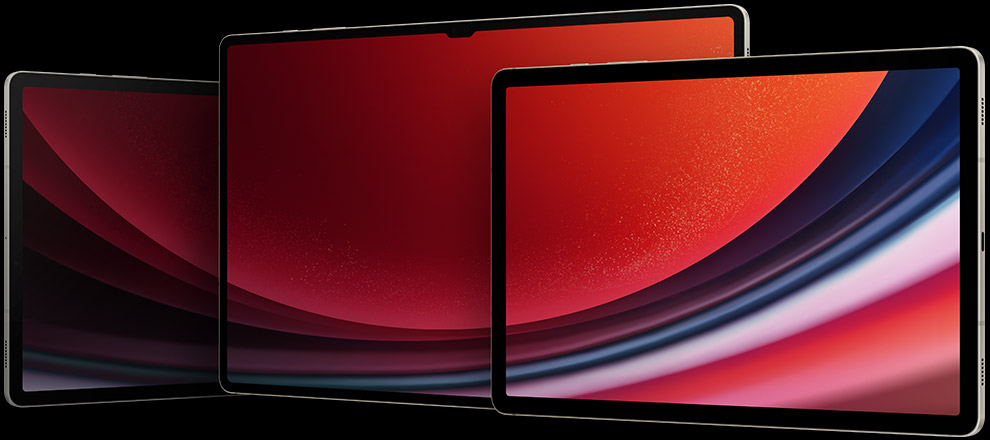
The new Galaxy Tab S9, S9 Plus, and S9 Ultra are Samsung’s newest high-end Android tablets introduced at the Samsung Unpack Event. The new versions have features and look that are similar to those of the Tab S8 series from 2022. The two bigger Tab S9 versions start at $999.99 and $1,199.99, respectively, while the smallest Tab S9 has a starting price of $799.99. Preorders for all of the tablets may be made starting today, July 26, while shipping starts on August 11.
What is different is the environment. For the past ten or so years, Samsung has essentially controlled the high-end Android tablet market. However, there are a surprisingly large number of other possibilities this year from brands like Google, OnePlus, and Lenovo, all of which provide distinct ideas for what a tablet might be – frequently at a lesser cost than what Samsung offers.

The Tab S9 family practically appears the same as it did previously, despite the new competition, thanks to improved CPUs and newer software (which will presumably be included in the older versions via updates this year). The top-tier tablets continue to emphasize productivity with multitasking and other power user features built into the OS. Additionally, optional keyboard cases are available for them, converting them into pseudo-laptops.
One noticeable change is that Samsung is now adopting OLED screens throughout the lineup rather than just the larger versions. The screens on all three tablets offer a refresh rate of up to 120Hz, allowing for fluid scrolling and a lower pen lag. The Tab S9 is 11 inches in size, the Tab S9 Plus is 12.4 inches, and the Tab S9 Ultra is a massive 14.6 inches. Unfortunately, Samsung has decided to continue with 16:10 aspect ratios across the board, which means that these tablets will operate best in landscape mode and will be more difficult to use for reading and other portrait-orientation use cases than an iPad or the OnePlus Pad.

Additionally, as a first for the series and to mirror what it offers on its premium smartphones, Samsung has given the Tab S9 tablets an IP68 rating for dust and water resistance. With the OLED panels and IP rating, Samsung is justifying its premium price and setting itself apart from the majority of other Android tablets and even the iPad. Water and dust protection of any kind is uncommon for tablets.
The Qualcomm Snapdragon 8 Gen 2 for Galaxy, which is exclusive to Samsung, powers all three Tab S9 versions. The 11-inch S9 basic model comes with 8GB of RAM; the other model of the lineup has 12GB, with the exception of the top-tier S9 Ultra, which has 16 GB. The Tab S9 comes with 128GB or 256GB of storage, the Tab S9 Plus has 256GB or 512GB of storage, and the Ultra can have up to 1TB of onboard space. The fact that all three still support microSD cards for storage expansion makes them stand out from modern Android tablets and the iPad.
Although Samsung claims that only the Tab S9 Plus will have 5G connectivity, it’s likely that the specific availability may vary by carrier and country. For the fastest home network speeds, Wi-Fi 6E is supported by all three models.

The S Pen stylus, a quad-speaker system with Dolby Atmos that is 20% bigger than before, and in-screen fingerprint scanners round out the hardware features. Users will still need to provide their own charging brick for the tablets, which are available in either graphite gray or beige.
Samsung’s new optional S Pen Creator Edition offers a more sophisticated writing or drawing experience with its larger size, rougher grip, and wider tilt angle. Additionally, it has the ability to switch between a softer and a firmer tip.
The Google Pixel Tablet and the OnePlus Pad don’t have as many productivity and multitasking options as Samsung’s software. Users can use the Dex feature to transition to a full desktop environment or use split-screen mode to run up to three apps at once. It is much simpler to complete tasks on Samsung tablets than on tablets made by competitors, especially if one relies on using many app windows at once. Samsung has been gradually improving these features over the years. Users of Samsung tablets now wirelessly copy, paste, or drag images to a compatible Samsung phone thanks to a new function called Multi Control.
Although the Tab S9 series will have outstanding performance and class-leading screens, most users would have wanted to see some more development. The price will continue to be the biggest barrier for most consumers because you can acquire an amazing tablet — like an Android or iPad — for far less than the $800 that even the most affordable Tab S9 requires.
Discover more from TechBooky
Subscribe to get the latest posts sent to your email.






